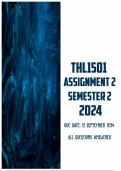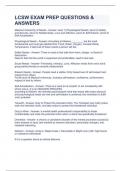, PLEASE USE THIS DOCUMENT AS A GUIDE TO ANSWER YOUR ASSIGNMENT
Please note that the author of this document will not responsibility for any plagiarizing you
commit.
Question 1
1. In her book, Basic Issues in Aesthetics (1998), cited in the Study Guide, Marcia Eaton
discusses the difficulties with defining the terms “beauty” and “aesthetics.” Referring to this
excerpt, in an essay of 500-800 words, argue that it is possible for these terms to be used
objectively. In other words, argue that it possible to define what “beauty” and “aesthetics” are.
You may refer to the examples Eaton uses but can also provide your own.
To tackle the question of whether "beauty" and "aesthetics" can be defined objectively, we must first
engage with the key issues and theories surrounding these terms. Marcia Eaton, in her book Basic
Issues in Aesthetics (1998), grapples with the inherent difficulties in defining these concepts, as
highlighted in the study guide. Eaton presents a complex view that reflects the longstanding debate
between subjective and objective interpretations of aesthetic judgment. However, I will argue that
despite these difficulties, it is indeed possible to define both "beauty" and "aesthetics" objectively by
grounding them in universally recognizable standards and principles that transcend personal or
cultural subjectivities.
Understanding Aesthetic Objectivity
Before delving into the question of whether beauty and aesthetics can be defined objectively, it is
essential to clarify what we mean by "objectivity" in this context. An objective definition is one that
is not dependent on individual feelings, tastes, or perceptions, but rather rests on universal principles
that can be consistently applied across different contexts. Objectivity in aesthetics refers to the
possibility that aesthetic judgments—such as the determination of beauty—can be evaluated based
on criteria that exist independently of personal biases or cultural conventions.
Subjectivity versus Objectivity in Aesthetic Theory
Eaton acknowledges that much of the difficulty in defining beauty and aesthetics stems from the
historical focus on subjectivity within aesthetic theory. For instance, philosophers like Immanuel
Kant in Critique of Judgment emphasized the role of personal taste in determining beauty, while also
recognizing that some judgments appear to have universal appeal. Kant’s “disinterested pleasure”
theory suggests that beauty involves a sense of pleasure that is free from personal desires or utility,
implying an attempt to locate a universal experience in subjective responses.
In contrast, philosophers such as David Hume have insisted that aesthetic judgments, while rooted in
individual experiences, can still reflect shared standards, especially when refined by education,
experience, and exposure to the arts. Hume's notion of "true judges" implies that objectivity in
aesthetic judgments can emerge from a consensus among experienced, discerning critics who possess
heightened sensitivity to artistic and cultural conventions. In other words, while individual responses
to beauty may vary, it is possible to establish objective criteria that can guide these judgments.





